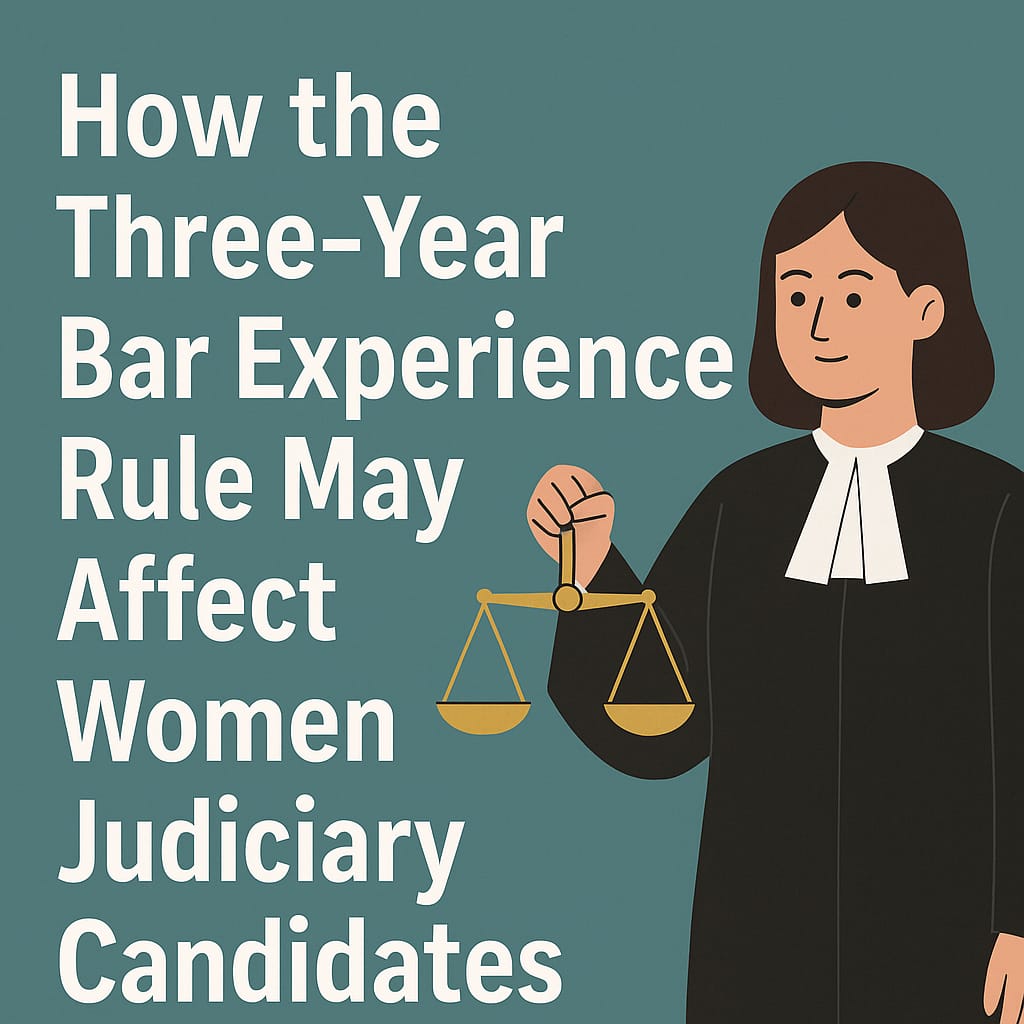Introduction
In a historic ruling in May 2025, the Supreme Court of India mandated that all candidates wishing to join the judiciary have at least three years of experience as active advocates. This action reversed a 2002 ruling that allowed fresh law graduates to take the judicial service tests immediately.The reform has sparked a national conversation about how it might impact women who want to enter the judiciary as well as its goals of enhancing judges’ qualifications through real-world legal experience. Although the change aims to ensure judges are more prepared, many fear it could make it even harder for female applicants. Women already have numerous challenges in the legal field, including social expectations and limited possibilities; this new rule could create yet another one.
Understanding the Three-Year Bar Experience Rule
To be eligible for positions like Judicial Magistrate or Civil Judge (Junior Division), candidates must have at least three years of experience as active advocates in the courtroom. The Supreme Court ruled that legal schools and training academies cannot substitute their theoretical knowledge for the practical wisdom and insight gained from actual legal practice. Additionally, the Court highlighted that judges who witness live court processes acquire the mindset and skills necessary for judgment.
Why This Rule Poses a Challenge for Women Aspirants
- Low Representation in Legal Practice
Even while more women are attending law schools these days, the percentage of active female advocates remains disproportionately low. The Bar Council of India reports that women make up only 15.31% of enrolled advocates. Even at the highest levels of government, such as the Supreme Court and High Courts, where their respective percentages are only 9.3% and 13.4%, women are under-represented.
This suggests that demanding practice could further distort the already biassed pool of possible judges.
- Societal Pressures and Gender Roles
Indian women are under a lot of pressure from society and their children to marry young and put their kids first. Particularly when they are in their 20s, these expectations frequently deter women from pursuing time-consuming and financially hazardous professions like litigation. The three-year practice requirement may therefore never be fulfilled by many capable women who aspire to and are able to function in the judiciary.
- Insufficient institutional assistance
Basic gender-sensitive amenities like breastfeeding or child care areas, women’s-only restrooms, and harassment protections are still lacking in many Indian courts. The lack of these support systems deters long-term legal practice, which is increasingly required for court admission.
.Potential Solutions to Ensure Gender Balance
Possible Remedies to Maintain Gender Parity
Enhancing judicial quality is a legitimate goal, but equity must not be sacrificed in the process. Among the balanced measures are:
- Apprenticeships or structured clerkships
A judicial apprenticeship model, in which recent law graduates spend two to three years working for sitting judges, can offer practical experience without the uncertainty of private litigation. - Gender-Based Reservations
The Supreme Court’s own recommendation to reserve 33% of Bar Association posts for women is one example of a reservation policy that may be implemented to recruiting in the judiciary to ensure fair representation. - Infrastructure for Support
Women can remain in the legal profession long enough to meet the new requirements with the support of gender-neutral court facilities, flexible work schedules, and maternity leave options for young advocates.
Conclusion
The three years of the mandatory bar praxis was meant to strengthen and professionalise the judiciary and is worthy of the effort. However, thought must also go into the possible repercussions that may exist. This could possibly make life harder still for women who wish to enter a predominantly male legal profession if suitable planning does not take place and study is not put into policies to support such an initiative. So, if in fact, the Indian judiciary truly cares about the democratic values that it stands for, it should surely concentrate on opening doors for all rather than having to reiterate those doors that are already closed.
About the Author
Vidhupriya Sharma is a second-year BA.LLB student at KIIT School of Law, Bhubaneswar, with a strong academic grounding and growing expertise in the field of law. As an aspiring legal professional, she has a deep interest in corporate and business law, driven by the dynamic interplay between legal frameworks and the evolving global economy.
Vidhupriya’s writing reflects a passion for simplifying complex legal concepts and making them accessible to a wider audience—students, professionals, and curious minds alike. Her academic background is complemented by an inquisitive approach to legal research, especially in the areas of mergers & acquisitions, company law, compliance, and financial regulation.
When not immersed in case law or legal debates, she enjoys contributing to law journals, participating in moot courts, and engaging in discussions around contemporary legal issues that shape the business world. Vidhupriya is determined to build a career that bridges academic insight with practical corporate legal practice

